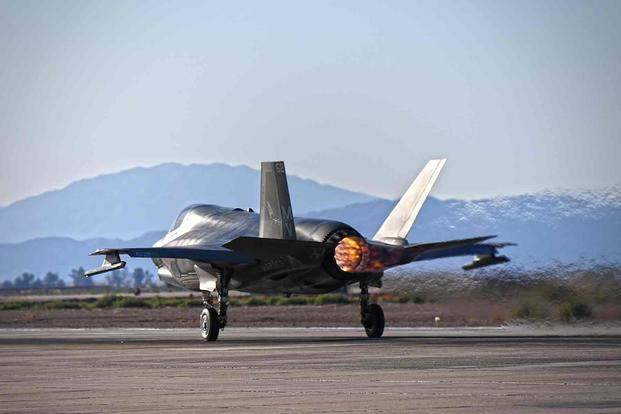F-35 Lightning IIs are being delivered to testing facilities again as production returns to normal after a dramatic crash on a Texas runway late last year grounded new models of the fighter jet.
The F-35 Lightning II Joint Program Office announced last month that engineers had identified a "rare system phenomenon" in F135 engines noticed during inspections that followed the Dec. 15 mishap, when a variant of the jet crashed on a runway at Naval Air Station Joint Reserve Base Fort Worth. Lockheed Martin, the defense contractor for the F-35, said the company is now delivering new jets.
"We resumed F-35 production flight operations today following a F135 engine mitigation action," Lockheed Martin tweeted Monday. "Safety remains our top priority as we continue to produce the world's most advanced fighter aircraft."
Read Next: Some Neck and Hand Tattoos OK for Airmen and Guardians Under New Policy Aimed at Helping Recruiting
A Marine Corps variant of the aircraft, an F-35B, crashed during a vertical landing attempt Dec. 15.
The F-35 Joint Program Office told Military.com on Dec. 28 that some models of the F-35 already delivered to the services had been grounded while the engine issue was investigated, but did not disclose the number of affected aircraft. It's not yet clear whether those jets have been allowed to fly.
Video footage posted online by CBS News' Dallas-Fort Worth station captured the December incident, with the F-35B attempting a vertical landing when, shortly after touching down, the aircraft's nose cone smashed into the ground and the jet began to rapidly spin.
The pilot ejected from the jet, and his parachute opened just before hitting the ground.
The pilot, an Air Force major who had been doing performance quality checks on behalf of the Defense Contract Management Agency, was released from the hospital shortly after the crash and suffered only minor injuries.
Lockheed Martin delivered 141 of the aircraft in 2022, according to a Dec. 30 press release. That was just shy of the 148 that the company was scheduled to deliver. The groundings caused by the Dec. 15 incident led to the shortfall.
Progress on putting new F-35s into the fleet comes as the military said last month it was grounding an undisclosed number of V-22 Osprey aircraft across the services, including the Air Force, due to a gearbox issue that has led to several incidents of engine trouble.
It also comes as the Air Force announced last month that hundreds of its KC-135 Stratotanker refueling planes, RC-135 Rivet Joint reconnaissance planes and WC-135 Constant Phoenix radiation detecting jets are being grounded as the service investigates a faulty part which, if not fixed, could potentially cause part of a plane's tail to fall off and lead to a crash.
-- Thomas Novelly can be reached at thomas.novelly@military.com. Follow him on Twitter @TomNovelly.
Related: After Crash Suspended F-35 Deliveries, Program Clears Hurdle











